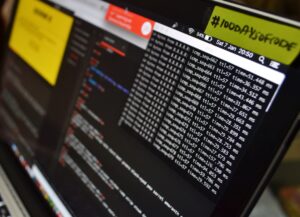Control flow in C programming refers to the order in which individual statements, instructions, or function calls are executed or evaluated. This fundamental concept is crucial for creating programs that can make decisions, repeat actions, and manage the flow of execution based on varying conditions. At its core, control flow allows developers to dictate how a program responds to different inputs and scenarios, enabling the creation of dynamic and responsive applications.
The primary building blocks of control flow in C are conditional statements and loops. Conditional statements, such as `if`, `else if`, and `else`, allow a program to execute certain blocks of code based on whether specific conditions are true or false. For instance, an `if` statement can check if a variable meets a certain criterion and execute a block of code accordingly.
Loops, on the other hand, enable repetitive execution of code blocks until a specified condition is met. The most common types of loops in C are `for`, `while`, and `do-while` loops, each serving different use cases depending on the requirements of the program. Understanding these basic constructs is essential for any programmer working with They form the foundation upon which more complex control flow mechanisms are built.
By mastering these elements, developers can create programs that not only perform tasks efficiently but also adapt to varying inputs and conditions, ultimately leading to more robust and flexible software solutions.
Key Takeaways
- Control flow in C programming determines the order in which statements are executed
- Advanced control flow techniques in C programming include nested if-else statements and the use of logical operators
- Conditional statements like if, else if, and else are used to create complex control flow in C programming
- Loops like for, while, and do-while are used to repeat a block of code for efficient control flow
- Switch statements are used for multi-branch control flow based on the value of a variable
- Functions and recursion can be used to master control flow in C programming, allowing for modular and repetitive tasks to be handled efficiently
Advanced Control Flow Techniques in C Programming
Once a programmer has grasped the basics of control flow, they can explore advanced techniques that enhance the functionality and efficiency of their code. One such technique is the use of nested control structures, where one control flow statement is placed inside another. This allows for more complex decision-making processes within a program.
For example, a nested `if` statement can be used to evaluate multiple conditions sequentially, enabling a program to handle intricate logic that would be cumbersome with simple linear statements. Another advanced technique involves the use of logical operators to combine multiple conditions within a single control statement. In C, logical operators such as `&&` (AND), `||` (OR), and `!` (NOT) can be employed to create compound conditions.
This capability allows programmers to streamline their code by reducing the number of separate conditional statements needed. For instance, instead of writing multiple `if` statements to check various conditions independently, a single statement can be crafted that evaluates all necessary conditions at once, improving readability and maintainability. Additionally, the use of the ternary operator (`?
:`) provides a concise way to express simple conditional logic in a single line. This operator can replace basic `if-else` statements when assigning values based on a condition, making the code more compact. For example, instead of writing several lines to check a condition and assign a value accordingly, the ternary operator allows for a more succinct expression: `int result = (condition) ?
value_if_true : value_if_false;`.
Utilizing Conditional Statements for Complex Control Flow

Conditional statements are pivotal in managing complex control flow within C programs. They allow developers to implement decision-making capabilities that can adapt based on user input or other runtime conditions. The `if` statement serves as the cornerstone of conditional logic in C, enabling programmers to execute specific blocks of code when certain criteria are met.
For instance, consider a scenario where a program needs to determine whether a user is eligible for a loan based on their credit score and income level. By using nested `if` statements, the program can evaluate multiple criteria sequentially, providing clear pathways for different outcomes. In addition to basic `if` statements, C offers the `switch` statement as an alternative for handling multiple conditions based on the value of a single variable.
This construct is particularly useful when dealing with discrete values or enumerated types. For example, if a program needs to execute different actions based on the day of the week represented by an integer (1 for Monday through 7 for Sunday), a `switch` statement can efficiently manage this branching logic without requiring multiple `if-else` checks. Each case within the switch can represent a different day, allowing for clear and organized handling of each scenario.
Moreover, combining conditional statements with logical operators can lead to even more sophisticated control flows. For instance, when checking for user input that must meet several criteria simultaneously—such as age and income level—logical operators can be employed within an `if` statement to ensure that all conditions are evaluated together. This approach not only simplifies the code but also enhances its readability by clearly expressing the intent behind the conditions being checked.
Source: Tutorialspoint – C Decision Making
Implementing Loops for Efficient Control Flow
| Loop Type | Description | Advantages | Disadvantages |
|---|---|---|---|
| For Loop | Executes a block of code a specified number of times | Explicit control over the number of iterations | Requires knowing the number of iterations in advance |
| While Loop | Executes a block of code as long as a specified condition is true | Flexible for situations where the number of iterations is not known in advance | Potential for infinite loops if the condition is not properly managed |
| Do-While Loop | Similar to a while loop, but the block of code is executed at least once before the condition is checked | Useful when the block of code must be executed at least once | Potential for infinite loops if the condition is not properly managed |
Loops are essential constructs in C programming that facilitate efficient control flow by allowing repetitive execution of code blocks based on specified conditions. The three primary types of loops—`for`, `while`, and `do-while`—each serve distinct purposes and offer unique advantages depending on the context in which they are used. The `for` loop is particularly well-suited for scenarios where the number of iterations is known beforehand.
It consists of three components: initialization, condition checking, and iteration expression, all contained within its header. For example, if a programmer needs to iterate through an array of integers to calculate their sum, a `for` loop can be employed effectively. The loop initializes an index variable, checks whether it is less than the size of the array, and increments it after each iteration.
This structure not only makes it easy to read but also ensures that the loop executes precisely as many times as there are elements in the array. In contrast, `while` loops are ideal for situations where the number of iterations is not predetermined but rather depends on dynamic conditions evaluated at runtime. A classic use case for a `while` loop is reading user input until a specific termination condition is met.
For instance, a program might prompt users to enter numbers until they input zero, at which point the loop terminates. This flexibility allows developers to create interactive applications that respond to user actions in real time. The `do-while` loop offers yet another variation by ensuring that the loop body executes at least once before checking its condition.
This characteristic makes it particularly useful in scenarios where an initial action must occur before any condition is evaluated—such as displaying a menu to users before processing their choices. By leveraging these looping constructs effectively, programmers can optimize their code for performance and clarity while managing complex control flows with ease.
Using Switch Statements for Multi-branch Control Flow
The `switch` statement in C programming provides an elegant solution for managing multi-branch control flow based on discrete values of an expression. Unlike multiple `if-else` statements that can become cumbersome and difficult to read when handling numerous conditions, a `switch` statement consolidates this logic into a more organized structure. Each case within the switch corresponds to a potential value of the expression being evaluated, allowing for clear delineation between different branches of execution.
For instance, consider a scenario where a program needs to determine an action based on user input representing different menu options—such as 1 for “Add,” 2 for “Subtract,” 3 for “Multiply,” and so forth. A switch statement can efficiently handle this branching logic by evaluating the user’s choice and executing the corresponding case block without unnecessary comparisons or checks. This not only enhances readability but also improves maintainability since adding or modifying cases becomes straightforward.
Moreover, switch statements can also incorporate fall-through behavior, where execution continues into subsequent cases unless explicitly terminated with a `break` statement. This feature can be advantageous when multiple cases share common functionality or when certain actions should apply across several values. For example, if both cases 1 and 2 require similar processing steps before diverging into distinct actions, they can be grouped together without duplicating code.
However, it is essential to use switch statements judiciously; they are best suited for scenarios involving discrete values rather than complex conditions or ranges. When dealing with continuous ranges or more intricate logic requiring multiple variables, traditional conditional statements may still be preferable. By understanding when and how to utilize switch statements effectively, programmers can streamline their control flow management while enhancing code clarity.
Mastering Control Flow with Functions and Recursion in C Programming

Modularizing Complex Problems
Functions allow developers to break down complex problems into smaller, manageable components—each responsible for a specific aspect of the overall functionality. This approach enables programmers to tackle intricate logic with ease, making their code more organized and easier to understand.
Recursion: A Powerful Technique for Managing Control Flow
In addition to standard function calls, recursion offers an advanced technique for managing control flow by allowing functions to call themselves under certain conditions. This approach is particularly useful for solving problems that exhibit recursive properties—such as calculating factorials or traversing tree structures—where solutions can be defined in terms of smaller subproblems.
Mastering Control Flow Techniques for Efficient Software Development
Combining functions with control flow constructs allows programmers to create sophisticated applications capable of handling complex logic while maintaining clarity and organization in their codebase. By mastering these techniques—both through traditional function calls and recursive approaches—developers can harness the full power of C programming’s control flow capabilities to build efficient and effective software solutions tailored to their specific needs.
If you’re interested in exploring the basics of a different topic, you may want to check out this article on phenomenology and key figures like Husserl and Kierkegaard. This article delves into the fundamental concepts and key figures in phenomenology, providing a comprehensive overview of this philosophical school of thought. It’s a fascinating read for anyone looking to deepen their understanding of philosophy and its key figures.
FAQs
What is the purpose of the break statement in C programming?
The break statement is used to terminate the current loop or switch statement and transfer control to the statement immediately following the terminated loop or switch.
What is the purpose of the continue statement in C programming?
The continue statement is used to skip the remaining code inside a loop for the current iteration and proceed to the next iteration of the loop.
What is the purpose of the exit() function in C programming?
The exit() function is used to terminate the program and return a specified status code to the operating system. It can be used to gracefully terminate the program or to handle error conditions.





















+ There are no comments
Add yours